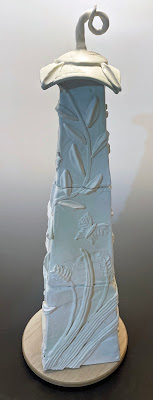Here's the thing. I should know by now that what I imagine is never what I make. You'd think I'd know that by now, and be able to head off disappointment before it, once again, catches me by surprise.
In the case of Folly, a lot Did go right. I was able to make the pieces fit nicely. The form came together mostly as envisioned, and the embellishments proved joyful work. The various sides are continued like a 4-sided canvas. It's true that the embellishments are more cliche. . .perhaps formulaic. . .than I would prefer, but all in all, I can overlook that. AND! I dried her slowly slowly, and through the drying, and both firings, there were no rebellious cracks.
The most terrible disappointment was the glaze. While it looks like it's only a flat white, I actually had lightly "kissed" the white with a dark green glaze. The green continued around the piece in a spiral. What green? For some reason it didn't show up at all in the finished piece. It's as though the Klaus Hard White swallowed the Coyote Matt Green. A disturbing thought. I had to cover over some dark green underglaze I had used on the hidden parts of the assembled piece because they showed up as horizontal lines dividing the vertical form. I did not like that one bit. Then, as I was doing that bit of magic, I dropped the lid and broke it. It was not a terrible break. . .I was able to glue it together admirably well. But I know it happened.
One of the things I loved about the concept of the piece is that it fits together as separate, discreet sections that can be used as a place for secret treasures, or as 3 separate vases.
It works just fine. However. I had imaged more graceful forms for the individual pieces. And now I'm left to wonder if I shouldn't have made the whole mess round instead of square. For the individual vessels, that would work better, I think, though I like the square format for Folly as her whole self.
For the sake of being complete, I'll include images of the other three sides.They're not bad. I may make a series. I love the idea of making them in porcelain, round, with No Glaze. Take that, Glaze.
There is some precedent for the idea of doing more Follies. Folly Camelot, Folly Royale. . .name your Folly. I made a large enameled torque back when I was enameling that was called 'Primal'. I loved making it, and it was actually sold before I displayed it, so it was satisfying on several levels. The last in the dozen or so I made was 'Primal domestica'. I traded that piece for an original painting by Jerry Lisk of Boise fame.
And isn't our current world so full of very upsetting Follies, that maybe some more whimsical Follies is just what we need. I'll have to think on it. Right now I'm exhausted with her.
























